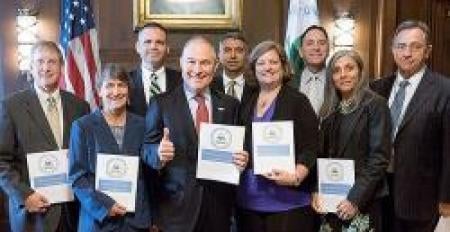Shortly after being confirmed as the new US EPA Administrator, Scott Pruitt appointed a Superfund Task Force to review the approximately 1,300 Superfund sites in the United States and make recommendations on how to improve and restructure the cleanup process. Administrator Pruitt observed that “many of these sites have been listed as Superfund sites for decades, some for as many as 30 years.” After a 30 day review, the Task Force released its set of recommendations on July 25, 2017, which set out five overarching goals, along with recommending specific actions, offering time frames for commencement, and identifying US EPA staff responsible for each action’s implementation. The specific actions outlined are all planned to commence within twelve months (by mid-2018) and many have been initiated immediately following the July 25th approval of the plan.
restructure the cleanup process. Administrator Pruitt observed that “many of these sites have been listed as Superfund sites for decades, some for as many as 30 years.” After a 30 day review, the Task Force released its set of recommendations on July 25, 2017, which set out five overarching goals, along with recommending specific actions, offering time frames for commencement, and identifying US EPA staff responsible for each action’s implementation. The specific actions outlined are all planned to commence within twelve months (by mid-2018) and many have been initiated immediately following the July 25th approval of the plan.
While extremely detailed, it is clear that each recommendation focuses on strategies to accelerate the cleanup process and repurpose contaminated sites. Below are the goals in the Task Force’s Recommendations and some key recommendations and strategies from each.
Goal #1: Expediting Cleanup and Remediation
The Task Force observes that in the past, US EPA has chosen to spread its resources thin across over 1,300 NPL sites while only making incremental process at each one. The Task Force recommends re-prioritizing some resources to focus on remedial actions, construction completions, ready-for-reuse determinations, and deletions off the NPL.
One of the most notable specific actions recommended is to develop a “Top Ten Administrator’s Emphasis List” of NPL sites determined to need serious and immediate attention. Other specific actions include promoting the use of “adaptive management strategies” at complex sites through the use of early/interim RODs and removal actions; closely tracking the remedy completion process at each NPL site using the Superfund Enterprise Management System (SEMS); and setting out appropriate timelines for each site. The Task Force also plans to clarify policies and guidance used for remediation, including updating the National Contingency Plan (NCP) which outlines key principles for groundwater restoration and clarifying priorities for Remedial Investigation/Feasibility Study (RI/FS) resources in order to address immediate risks.
Goal #2: Re-Invigorating Responsible Party Cleanup and Reuse
The Task Force’s primary focus under this goal is to encourage responsible parties to settle early. According to the Task Force, this will lead to more expeditious and thorough cleanups.
Notably, the Task Force recommends giving specific financial incentives to Potentially Responsible Parties (PRPs) who agree to perform cleanup work. This includes prioritizing the use of special account funds, disbursing funds quicker to PRPs who complete work ahead of schedule or on time, and developing guidance for disbursing special account funds to Bona Fide Prospective Purchasers (BFPPs) who agree to perform cleanup work.
Goal #3: Encouraging Private Investment
Because parties often allocate environmental risk and liabilities among themselves to pay for site cleanup or reuse contaminated sites, the Task Force recommends that US EPA support these innovative approaches to promote third-party investment in cleanup and reuse of contaminated properties consistent with statutory authorities. This would include supporting Environmental Liability Transfers (ELTs) and other risk management tools for third parties interested in buying or selling a contaminated site.
Also, the Task Force recommends creating an Office of Enforcement and Compliance Assurance (OECA) Information Repository to provide access to enforcement information and tools to support third-party cleanup and reuse including template comfort/status letters and settlement agreements. It further recommends developing a new policy memorandum in conjunction with the Office of General Counsel and Department of Justice which provides greater use of Prospective Purchaser Agreements (PPAs) and windfall lien resolution agreements with third parties in addition to BFPP agreements at NPL sites.
Goal #4: Promoting Redevelopment and Community Revitalization
The Task Force’s main focus under this goal is to ensure that the community, and particularly developers, have access to more information about an individual site and the sites around it. The Task Force recommends determining which types of sites businesses or developers are interested in potentially redeveloping and making sure to share information with them about those specific sites.
Specifically, the Task Force recommends developing “reuse” fact sheets during the remedial design in order to provide site information to the community and local stakeholders. It also recommends identifying 20 NPL sites with the greatest reuse and commercial potential considering input from regions and agreed-upon criteria, then identifying the industries and businesses that may be interested in reusing those sites and also ensuring that the developers understand liabilities and any ongoing obligation at those sites. This idea was based on the successes of US EPA’s Region 4, which so far has given out “Excellence in Site Reuse Awards” to 18 Superfund sites located in 6 different states.
Goal #5: Engaging Partners and Stakeholders
The Task force recommends developing partnership building activities and engagement opportunities to increase the collaboration with and the impact of local stakeholders, including state and local entities, businesses, responsible parties, and grassroots organizations. Some of these strategies include traditional engagement activities, such as public and private meetings. However, others include soliciting specific information from PRPs and state and local governmental entities. The Task Force ultimately recommends a Federal Advisory Committee to identify methods and ideas to achieve more engagement.
Overall, while it is still too early to determine how the Task Force Recommendations will impact current Superfund sites or the parties engaged in transactions at Superfund sites, US EPA has made clear that it is prioritizing a more expedited and targeted process for cleanup, along with implementing a fairly practical plan to allow for greater site reuse following cleanup. It may be beneficial for responsible parties and local stakeholders to focus on the same goals, too.




 />i
/>i
